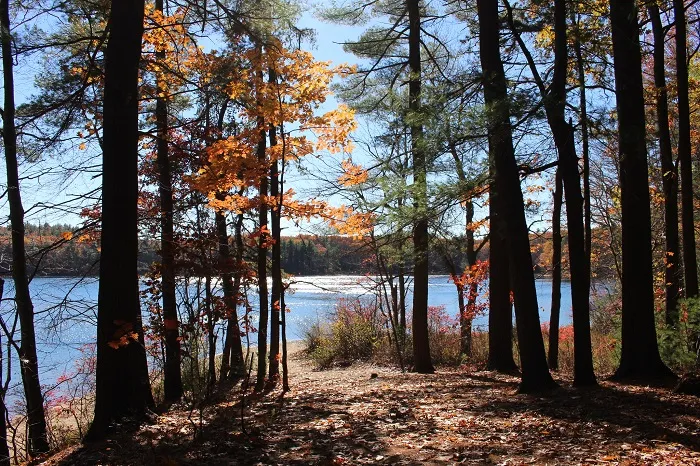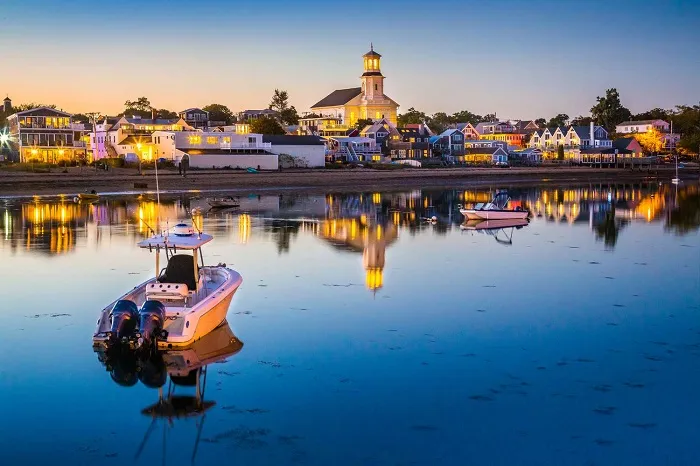Massachusetts, a state celebrated for its rich history and vibrant cities, harbors a priceless natural treasure: its ecological reserves. These protected areas are not only safe havens for diverse wildlife but also ideal destinations for those seeking to immerse themselves in unspoiled nature and explore the natural beauty of New England. From coastal forests to majestic mountains, Massachusetts presents a diverse and colorful natural tapestry, worthy of your exploration and appreciation.
I. Why Are Massachusetts Nature Preserves Important?
Nature preserves play a crucial role in maintaining ecological balance and conserving biodiversity. Massachusetts, despite being a developed state, deeply recognizes the importance of protecting its natural environment. The ecological reserves here not only safeguard rare flora and fauna but also provide significant benefits to the community:
- Biodiversity Conservation: Massachusetts is a convergence zone for various ecosystems, from coniferous forests, mixed forests, coastal wetlands to high-altitude mountain ecosystems. Nature preserves help protect these ecosystems and the species that depend on them, including many endangered species.
- Ecosystem Services: Nature preserves provide essential services to humans, such as climate regulation, water filtration, flood control, and sustainable natural resource provision. Forests and wetlands absorb carbon dioxide, helping mitigate climate change. Natural areas also act as “green lungs,” providing clean air for communities.
- Education and Research: Nature preserves are invaluable natural laboratories for scientists and researchers. They offer opportunities to study ecological processes, the impacts of climate change, and effective conservation measures. Simultaneously, they are excellent places to educate the community about the importance of nature and promote environmental awareness.
- Ecotourism and Recreation: Nature preserves offer excellent opportunities for ecotourism and outdoor recreational activities such as hiking, bird watching, kayaking, and camping. Ecotourism not only helps people relax and enjoy nature but also contributes to the local economy and raises conservation awareness.
II. Discovering the Most Outstanding Nature Preserves in Massachusetts
Massachusetts proudly boasts an extensive network of nature preserves, each with its unique beauty and characteristics. Below are some exemplary nature preserves you shouldn’t miss when visiting this state:
1. Stellwagen Bank National Marine Sanctuary
Located off the coast of Massachusetts, Stellwagen Bank National Marine Sanctuary is one of the most biologically productive ocean environments in the world. This marine area is where the cold Labrador Current and the warm Gulf Stream converge, creating an incredibly rich marine ecosystem.

Highlights:
- Whale Watching: Stellwagen Bank is renowned as an ideal whale watching destination. Annually, thousands of humpback, finback, and right whales migrate here to feed. Whale watching tours depart from many coastal towns such as Boston, Plymouth, and Cape Cod towns, offering unforgettable experiences to witness these giant marine creatures firsthand.
- Marine Biodiversity: Besides whales, Stellwagen Bank is also home to many other marine species such as seals, dolphins, seabirds, sharks, and various fish species. Underwater coral reefs and seagrass beds provide crucial habitats for many benthic organisms.
- Tourism Activities: Visitors can participate in whale watching tours, recreational fishing, scuba diving, and explore the diverse marine ecosystem. The Stellwagen Bank Visitor Center provides detailed information about the sanctuary and its marine life.
Travel Tips:
- Best Time to Visit: Summer and fall are the best times for whale watching at Stellwagen Bank.
- Choose Reputable Tours: Opt for certified whale watching tours that adhere to conservation guidelines to ensure safety for both tourists and wildlife.
- Preparation: Bring warm clothing, hats, sunscreen, and seasickness medication if you are prone to motion sickness.
2. Mount Watatic State Wildlife Management Area
Mount Watatic State Wildlife Management Area, spanning 1,750 acres in Ashburnham, Massachusetts, is a hidden gem nestled in peaceful countryside. It’s an ideal destination for outdoor enthusiasts and those wanting to explore the unspoiled beauty of New England’s forests and mountains.

Highlights:
- Hiking: Mount Watatic features a diverse network of hiking trails suitable for all skill levels. The Summit Trail leading to the peak of Mount Watatic (1,832 feet) offers stunning panoramic views of the surrounding countryside, including Boston on clear days. The Laurel Loop Trail winds around the picturesque Laurel Lake, an ideal choice for a leisurely stroll.
- Wildlife Observation: The preserve is home to various wildlife species such as white-tailed deer, red foxes, raccoons, squirrels, woodpeckers, and many other bird species. Visitors can observe wildlife in their natural habitat while hiking or camping.
- Camping and Fishing: The preserve has over 100 campsites open from May to October, offering a wilderness camping experience. Laurel Lake and streams within the preserve are ideal fishing spots where you can catch trout, bass, and other freshwater fish.
Travel Tips:
- Best Time to Visit: Spring, summer, and fall are ideal times to visit Watatic preserve. Fall is particularly appealing with vibrant foliage.
- Preparation: Bring comfortable hiking shoes, weather-appropriate clothing, water, snacks, sunscreen, and insect repellent.
- Camping Reservations: If you plan to camp, reservations are recommended, especially during peak season.
3. Cape Cod National Seashore
Cape Cod National Seashore is a vast nature preserve stretching over 40 miles along the Atlantic coast of Cape Cod peninsula. It protects a unique and diverse coastal ecosystem, including sandy beaches, dunes, salt marshes, pine forests, and freshwater ponds.

Highlights:
- Pristine Beaches: Cape Cod is famous for its endless stretches of fine white sand beaches, considered among the most beautiful in the United States. Marconi Beach, Nauset Beach, and Race Point Beach are popular destinations for swimming, sunbathing, surfing, and beach walks.
- Historic Lighthouses: Cape Cod has numerous historic lighthouses, playing a crucial role in guiding ships through these treacherous waters. Highland Light, Nauset Light, and Race Point Light are famous lighthouses you can visit and learn about the area’s maritime history.
- Hiking and Biking: The preserve features over 400 miles of hiking and biking trails, traversing diverse ecosystems and stunning landscapes. The Province Lands Bike Trail is an excellent coastal cycling route, offering breathtaking views of the Atlantic Ocean and dunes.
- Bird Watching: Cape Cod is a significant stopover on the migratory route for many bird species. The preserve is a paradise for bird lovers, with opportunities to observe various seabirds, waterfowl, and migratory birds.
Travel Tips:
- Best Time to Visit: Summer is the most popular time to visit Cape Cod, but spring and fall also offer pleasant weather and fewer crowds.
- Transportation: Cars are the most convenient way to explore Cape Cod. However, you can also use buses or bikes to travel between towns and attractions.
- Book in Advance: If you plan to stay overnight or join tours, booking in advance is recommended, especially during peak season.
4. Martha’s Vineyard Preserve
Martha’s Vineyard, a beautiful island off the coast of Massachusetts, is not only a famous resort destination but also a valuable ecological preserve. The island boasts incredible biodiversity, from oak and pine forests to salt marshes, freshwater ponds, and sandy beaches.

Highlights:
- Aquinnah Cliffs: Aquinnah Cliffs (formerly Gay Head Cliffs) are a renowned natural wonder of Martha’s Vineyard. The multicolored clay cliffs formed millions of years ago, creating a unique and impressive landscape. Moshup Beach at the foot of the cliffs is a great destination for swimming and exploring the area’s unique geology.
- Diverse Ecosystems: Martha’s Vineyard is a meeting point of various ecosystems, each supporting a unique community of organisms. Oak and pine forests are habitats for many bird, mammal, and insect species. Salt marshes and freshwater ponds are crucial habitats for waterfowl, fish, and amphibians.
- Outdoor Activities: Visitors can enjoy numerous outdoor activities on Martha’s Vineyard such as hiking, biking, kayaking, fishing, bird watching, and swimming. Felix Neck Wildlife Sanctuary and Long Point Wildlife Refuge are ideal locations to explore the island’s wilderness.
Travel Tips:
- Transportation: To reach Martha’s Vineyard, you can take a ferry from Massachusetts ports like Woods Hole, Hyannis, and Falmouth. On the island, you can travel by bus, bike, or rent a car.
- Explore Towns: Martha’s Vineyard has many charming towns such as Edgartown, Oak Bluffs, and Vineyard Haven, each with its own beauty and character. Spend time exploring local shops, restaurants, and art galleries.
- Respect Nature: When visiting nature preserves on Martha’s Vineyard, remember to follow conservation guidelines, do not litter, do not disturb wildlife, and stay on designated trails.
III. Sustainable Ecotourism in Massachusetts
When exploring Massachusetts’ nature preserves, remember to practice sustainable ecotourism to protect these green gems for future generations. Here are some helpful tips:
- Learn About the Preserve: Before visiting, learn about the preserve, including regulations, trails, characteristic flora and fauna, and environmental threats.
- Stay on Designated Trails: Always stay on marked trails to avoid disturbing natural habitats and protect vegetation.
- Pack Out All Trash: Carry out all your waste from the preserve and dispose of it properly. Minimize single-use plastics and prioritize eco-friendly products.
- Do Not Disturb Wildlife: Observe wildlife from a distance and do not feed or approach them too closely. Keep quiet to avoid scaring them.
- Support Local Economy: Prioritize using local tourism services such as accommodations, restaurants, and tours operated by local residents to contribute to the community economy and encourage conservation.
- Minimize Impact: Use public transportation, bikes, or walk when possible. Conserve water and energy when in the preserve or nearby accommodations.
Massachusetts’ nature preserves are not only attractive tourist destinations but also symbols of the state’s commitment to nature conservation. Exploring these areas is an excellent opportunity to immerse yourself in beautiful nature, learn about biodiversity, and raise environmental awareness. Plan your trip to explore Massachusetts nature preserves today and experience the wonders that nature offers!
References
- Massachusetts Department of Conservation and Recreation: https://www.mass.gov/orgs/department-of-conservation-recreation
- Mass Audubon: https://www.massaudubon.org/
- The Trustees of Reservations: https://thetrustees.org/
- National Park Service – Cape Cod National Seashore: https://www.nps.gov/caco/index.htm
- Stellwagen Bank National Marine Sanctuary: https://stellwagen.noaa.gov/
- Martha’s Vineyard Chamber of Commerce: https://www.mvy.com/